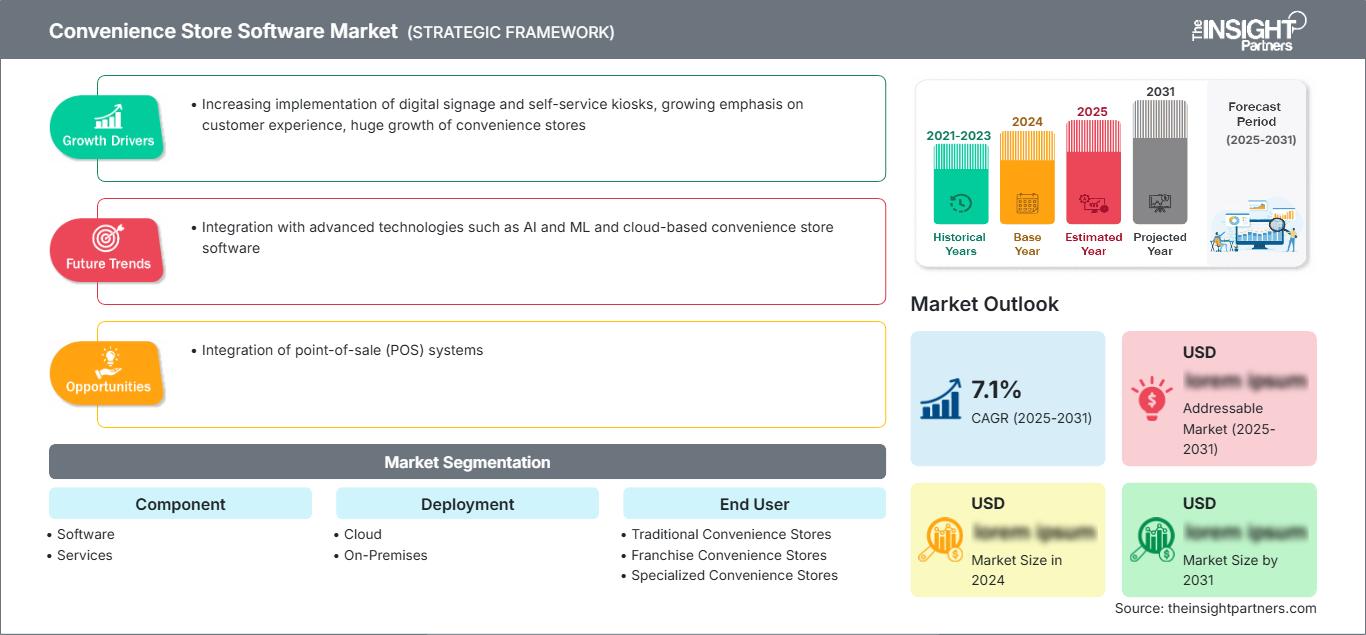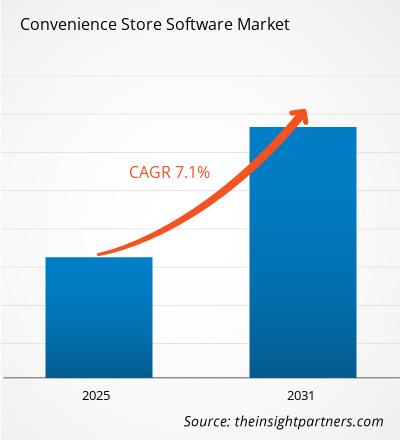Si prevede che il mercato del software per minimarket registrerà un CAGR del 7,1% nel periodo 2023-2031. L'integrazione dei sistemi POS (Point-of-Sale) è destinata a rimanere una tendenza chiave nel mercato.
Analisi del mercato del software per minimarket
- Il mercato del software per minimarket presenta prospettive di crescita dovute alle attuali tendenze del mercato e al loro impatto prevedibile durante il periodo di previsione.
- Il mercato del software per minimarket è in crescita grazie a fattori quali la crescente implementazione di segnaletica digitale e chioschi self-service, la crescente enfasi sull'esperienza del cliente e l'enorme crescita dei minimarket.
- L'integrazione con tecnologie avanzate come l'intelligenza artificiale e l'apprendimento automatico e il software per minimarket basato su cloud offre opportunità redditizie per il mercato del software per minimarket.
Panoramica del mercato del software per minimarket
- Il software per minimarket è un tipo di soluzione sviluppata per piccole attività di vendita al dettaglio e minimarket.
- Il software per minimarket incorpora diverse funzionalità necessarie affinché un minimarket operi in modo redditizio, tra cui la rendicontazione finanziaria, la pianificazione dei dipendenti, il monitoraggio delle vendite, la gestione dell'inventario e la fidelizzazione dei clienti. programmi.
- Questo software spesso include funzionalità su misura per le esigenze specifiche dei minimarket, come la gestione del carburante per i negozi con pompe di benzina, la verifica dell'età per la vendita di tabacco e alcolici e l'integrazione con i sistemi di lotteria.
- Il software per minimarket aiuta i proprietari e i gestori a prendere decisioni informate, migliorare il servizio clienti e aumentare la redditività ottimizzando le operazioni e offrendo dati in tempo reale.
Personalizza questo rapporto in base alle tue esigenze
Potrai personalizzare gratuitamente qualsiasi rapporto, comprese parti di questo rapporto, o analisi a livello di paese, pacchetto dati Excel, oltre a usufruire di grandi offerte e sconti per start-up e università
Mercato del software per negozi di alimentari: Approfondimenti strategici

-
Ottieni le principali tendenze chiave del mercato di questo rapporto.Questo campione GRATUITO includerà l'analisi dei dati, che vanno dalle tendenze di mercato alle stime e alle previsioni.
- I minimarket stanno diventando sempre più punti di riferimento per la spesa veloce, il cibo e altro ancora, ridefinendo il panorama della vendita al dettaglio.
- Il numero di minimarket è aumentato in tutto il mondo. I dati del censimento NACS rivelano un aumento costante del numero di minimarket.
- Ad esempio, secondo NACS, la principale associazione commerciale mondiale dedicata alla promozione della vendita al dettaglio di minimarket e carburanti, a gennaio 2024, negli Stati Uniti erano operativi 152.396 minimarket, con un aumento dell'1,5% rispetto al numero di negozi del 2023 (150.174 minimarket).
- Secondo la stessa fonte, quasi tutti gli stati hanno aumentato il numero di negozi, incluso il Texas, che continua ad avere il maggior numero di minimarket (16.304 negozi).
- Un numero così crescente di minimarket aumenta anche l'adozione di software per minimarket, contribuendo così alla crescita del mercato del software per minimarket.
Software per minimarket basato su cloud
- Oggigiorno, molte aziende stanno passando a software per minimarket basati su cloud grazie ai suoi vantaggi.
- Le organizzazioni possono archiviare i dati in tempo reale con lo spazio fornito Grazie alle tecnologie basate sul cloud. Il software per minimarket basato sul cloud consente la gestione dell'inventario in tempo reale, operazioni semplificate nei punti vendita e approfondimenti basati sui dati, consentendo ai proprietari dei negozi di ottimizzare le proprie operazioni e migliorare l'esperienza dei clienti.
- Il software tradizionale è in genere significativamente più costoso della tecnologia basata sul cloud. Il software per minimarket basato sul cloud riduce i costi iniziali di investimento e manutenzione, facilitando al contempo la gestione remota e gli aggiornamenti senza interruzioni.
- Il software per minimarket basato sul cloud aiuta a tenere traccia delle vendite, dell'inventario e persino delle pratiche contabili, riducendo l'errore umano. Inoltre, libera tempo per concentrarsi su altri aspetti aziendali.
- Pertanto, il software per minimarket basato su cloud offre significative opportunità di crescita del mercato, fornendo ai rivenditori soluzioni convenienti, scalabili e facilmente accessibili.
Analisi della segmentazione del rapporto di mercato del software per minimarket
I segmenti chiave che hanno contribuito alla derivazione dell'analisi del mercato del software per minimarket sono componente, distribuzione e utente finale.
- Per componente, il mercato è suddiviso in software e servizi.
- Per distribuzione, il mercato è suddiviso in cloud e on-premise.
- Per utente finale, il mercato è segmentato in minimarket tradizionali, minimarket in franchising, minimarket specializzati, catene multi-store e altri.
Analisi della quota di mercato del software per minimarket per area geografica
- Il rapporto di mercato del software per minimarket comprende un'analisi dettagliata di cinque principali regioni geografiche, che include le dimensioni attuali e storiche del mercato e le previsioni per il 2021. fino al 2031, coprendo Nord America, Europa, Asia-Pacifico (APAC), Medio Oriente e Africa (MEA) e America Meridionale e Centrale.
- Ogni regione è ulteriormente suddivisa in sottosegmenti nei rispettivi Paesi. Questo rapporto fornisce analisi e previsioni per oltre 18 Paesi, coprendo le dinamiche del mercato del software per minimarket, come fattori trainanti, tendenze e opportunità che influenzano i mercati a livello regionale.
- Inoltre, il rapporto include l'analisi PEST, che prevede lo studio dei principali fattori che influenzano il mercato del software per minimarket in queste regioni.
Mercato del software per negozi di alimentari
Le tendenze regionali e i fattori che influenzano il mercato del software per minimarket durante il periodo di previsione sono stati ampiamente spiegati dagli analisti di The Insight Partners. Questa sezione analizza anche i segmenti e la geografia del mercato del software per minimarket in Nord America, Europa, Asia-Pacifico, Medio Oriente e Africa, America Meridionale e Centrale.
Ambito del rapporto di mercato del software per negozi di alimentari
| Attributo del rapporto | Dettagli |
|---|---|
| Dimensioni del mercato in 2024 | US$ XX million |
| Dimensioni del mercato per 2031 | US$ XX Million |
| CAGR globale (2025 - 2031) | 7.1% |
| Dati storici | 2021-2023 |
| Periodo di previsione | 2025-2031 |
| Segmenti coperti |
By Componente
|
| Regioni e paesi coperti |
Nord America
|
| Leader di mercato e profili aziendali chiave |
|
Densità degli operatori del mercato del software per negozi di alimentari: comprendere il suo impatto sulle dinamiche aziendali
Il mercato del software per i minimarket è in rapida crescita, trainato dalla crescente domanda degli utenti finali, dovuta a fattori quali l'evoluzione delle preferenze dei consumatori, i progressi tecnologici e una maggiore consapevolezza dei vantaggi del prodotto. Con l'aumento della domanda, le aziende stanno ampliando la propria offerta, innovando per soddisfare le esigenze dei consumatori e sfruttando le tendenze emergenti, alimentando ulteriormente la crescita del mercato.

- Ottieni il Mercato del software per negozi di alimentari Panoramica dei principali attori chiave
Il mercato del software per minimarket viene valutato raccogliendo dati qualitativi e quantitativi dopo ricerche primarie e secondarie, che includono importanti pubblicazioni aziendali, dati di associazioni e database. Di seguito sono elencati alcuni degli sviluppi nel mercato del software per minimarket:
- La catena di minimarket Stinker Stores sta collaborando con NCR Voyix, Atlanta, per modernizzare la propria tecnologia informatica in-store. Dall'implementazione della piattaforma NCR Voyix Commerce tramite infrastruttura Edge, "un ambiente di vendita a prova di futuro che virtualizza il sistema POS (point-of-sale) e migliora sia la tecnologia legacy che quella moderna, Stinker ha aumentato i propri profitti, massimizzato le prestazioni dell'infrastruttura del suo punto vendita e migliorato l'esperienza del cliente attraverso promozioni in tempo reale in tutti i suoi punti vendita. (Fonte: Stinker Stores, comunicato stampa, agosto 2024)
- La piattaforma di commercio per minimarket Vroom Delivery ha avviato una partnership con l'elaboratore di pagamenti Finix. La collaborazione è incentrata sulla creazione di un nuovo strumento chiamato Pay360, che secondo le aziende è la prima soluzione di pagamento online progettata per il settore dei minimarket, consentendo la vendita online sicura di prodotti soggetti a restrizioni di età. (Fonte: Vroom Delivery, comunicato stampa, aprile 2024)
- VCA Technology e C Store Collective uniscono le forze per rivoluzionare il mercato della vendita al dettaglio nei minimarket. Questa partnership tra VCA Technology e C Store Collective mirava a trasformare il panorama della vendita al dettaglio nei minimarket. Combinando il software di analisi video all'avanguardia di VCA con i servizi di consulenza specialistica di C Store Collective, l'azienda stava rivoluzionando il modo in cui i rivenditori affrontano sicurezza, protezione e redditività. (Fonte: VCA Technology, comunicato stampa, febbraio 2024)
Copertura e risultati del rapporto sul mercato del software per minimarket
Dimensioni e previsioni del mercato del software per minimarket (2021-2031) Il rapporto fornisce un'analisi dettagliata del mercato che copre le seguenti aree:
- Dimensioni e previsioni del mercato del software per minimarket a livello globale, regionale e nazionale per tutti i segmenti di mercato chiave coperti dall'ambito
- Tendenze del mercato del software per minimarket, nonché dinamiche di mercato come fattori trainanti, vincoli e opportunità chiave
- Analisi dettagliata delle cinque forze PEST/Porter e SWOT
- Analisi del mercato del software per minimarket che copre le principali tendenze del mercato, il quadro globale e regionale, i principali attori, le normative e i recenti sviluppi del mercato
- Analisi del panorama del settore e della concorrenza che copre la concentrazione del mercato, l'analisi della mappa termica, i principali attori e i recenti sviluppi per il mercato del software per minimarket
- Profili aziendali dettagliati
- Analisi storica (2 anni), anno base, previsione (7 anni) con CAGR
- Analisi PEST e SWOT
- Valore/volume delle dimensioni del mercato - Globale, Regionale, Nazionale
- Industria e panorama competitivo
- Set di dati Excel
Report recenti
Rapporti correlati
Testimonianze
Motivo dell'acquisto
- Processo decisionale informato
- Comprensione delle dinamiche di mercato
- Analisi competitiva
- Analisi dei clienti
- Previsioni di mercato
- Mitigazione del rischio
- Pianificazione strategica
- Giustificazione degli investimenti
- Identificazione dei mercati emergenti
- Miglioramento delle strategie di marketing
- Aumento dell'efficienza operativa
- Allineamento alle tendenze normative






















 Ottieni un campione gratuito per - Mercato del software per negozi di alimentari
Ottieni un campione gratuito per - Mercato del software per negozi di alimentari